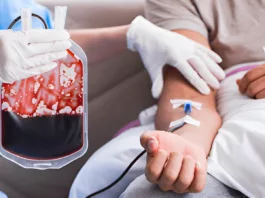Anemia simply means low blood count, and while many anemic cases are due to nutritional deficiencies, some cases can be genetic. Hence, the question, ‘Is anemia hereditary’ is somewhat true.
From gene mutations to deletions to chromosome changes, genetic anemias have various types and are often present at birth. Breathlessness, lightheadedness, and fatigue are common anemia complaints, and while most doctors will now screen you during pregnancy for these anemias, lifelong management is always required.
What is Anemia?
Anemia is a global health concern since the World Health Organization states that 40 percent of women and 42 percent of kids below five years of age are anemic.1World Health Organization, 2023. Anemia. https://www.who.int/health-topics/anaemia#tab=tab_1
It is a condition in which there is a decline in healthy red blood cell count. Almost in every anemic case, a protein called hemoglobin is directly affected and reduced. Hemoglobin helps transfer oxygen to the body’s tissues and forms the main structure of a red blood cell. Normal hemoglobin ranges include2Beutler, E. and Waalen, J., 2006. The definition of anemia: what is the lower limit of normal blood hemoglobin concentration? Blood, 107(5), pp.1747-1750. :
- 12-15 g/dl in women.
- 15-18g/dl in men.
- 11-16g/dl in children.
- There are fluctuations in hemoglobin concentration in pregnancy, but normally it is more than ten g/dl.
Anything less than these will be labeled as anemia.
How is Anemia Hereditary? Types:
While the most common form of anemia, called iron deficiency anemia, is due to nutritional iron deficiency, some anemias are genetic.
Hereditary means something passed on from generations; in terms of genetic anemia, either the parents are actively affected or could be carriers (having a defective gene but no symptom). Some common hereditary anemias are:
Sickle Cell Anemia
Is anemia hereditary? Regarding sickle cell anemia, yes, it is one of the most common genetic blood disorders globally.
Sickel cell anemia results from a gene mutation in the beta chain of hemoglobin. The mutation has a recessive pattern, meaning both parents must give the child a defective copy of their gene. Amino acid replacement of glutamic acid by valine leads to the change in the shape of blood cells from disc to needle-like. 3Fasano, R.M., Meier, E.R. and Chonat, S., 2022. Sickle cell disease, thalassemia, and hereditary hemolytic anemias. Rossi’s Principles of Transfusion Medicine, pp.326-345.
Therefore, sickle cell disease is a lifelong problem that can lead to kidney failure, swollen hands, breathing issues, and a regular need for blood transfusions.
Thalassemia
Thalassemia occurs due to an abnormality in the structure of either alpha or beta chain of the hemoglobin. The patients can either be carriers meaning they have a positive gene but show no signs and symptoms, or can be actively affected. Common findings include soft bones, increased risk of infection death, and increased skull size.
Thalassemia is an inherited disorder that runs in families4Sonati, M.D.F. and Costa, F.F., 2008. The genetics of blood disorders: hereditary hemoglobinopathies. Jornal de Pediatria, 84, pp.S40-S51.. Thalassemia has two types depending on the chain involvement.
- Alpha thalassemia due to gene deletion in the alpha chain on chromosome 16.
- Beta thalassemia due to gene mutation in beta chains of chromosome 11.
Beta thalassemia major is the most dangerous and life-threatening subtype of thalassemia, requiring lifelong blood transfusion and monitoring.
Hereditary Spherocytosis
In this anemia, red blood cells lose their normal disc shape. This occurs due to alterations in the proteins of red blood cells. The red blood cells break down at a faster rate than normal ones. People with this condition present with an enlarged spleen. It is an autosomal dominant disorder, meaning that only one affected gene from parent to child will cause this condition.
Newborn children with this condition often present with jaundice, and phototherapy is used as a light treatment option for them.
Glucose 6 Phosphatase Deficiency Anemia
Glucose 6 Phosphatase deficiency anemia is due to the absence of an enzyme that protects our red blood cells from damage. This causes excessive destruction of blood cells, and they are destroyed prematurely. People with a deficiency of this enzyme can experience symptoms of anemia when they are exposed to certain medications like antimalarial drugs and fava beans.
It is an X-linked recessive trait, meaning that male children are likelier to get this disease from an affected father or mother. Female kids are less affected because both X chromosomes should have the variant of the illness.
The treatment includes discontinuing certain medications and blood transfusion in case of severe anemia.
Non-Genetic Types
Some hereditary forms of anemia that can be acquired during any phase of life include:
- Iron deficiency anemia is due to iron deficiency or heavy periods, as anemia and period are interlinked.
- Megaloblastic anemia due to folate and B12 deficiencies.
- Sideroblastic anemia due to decreased synthesis of hemoglobin.
- Aplastic anemia due to bone marrow problems.
Symptoms of Hereditary Anemia
Symptoms of anemia are mild to moderate initially, but they become more exaggerated as anemia worsens.
- Tiredness and exhaustion
- Weakness
- Dizziness
- Chest pain
- Difficulty in breathing (shortness of breath)
- Abnormal heartbeat
- Heart racing
- In more severe cases, anemia bruising is also seen
Does Hereditary Anemia Cause Headaches?
The drastic effects on health from anemia arise due to a decrease in oxygen supply to the multiorgan system, e.g., a low iron level in iron deficiency anemia hurts brain functioning and development.5Chaparro, C.M. and Suchdev, P.S., 2019. Anemia epidemiology, pathophysiology, and etiology in low‐and middle‐income countries. Annals of the New York Academy of Sciences, 1450(1), pp.15-31. The brain needs oxygen to function optimally, and a limited supply results in headaches. Sickle cell anemia and thalassemia cause clumping of red blood cells that form clots. Which also leads to a headache.
Moreover, anemia is a risk factor for forming clots in the veins of the brain, a condition known as cerebral venous thrombosis, which can be life-threatening.
Is Anemia Hereditary? How do we find out through Tests?
- Complete Blood Count: A complete picture showing the hemoglobin, hematocrit, MCV, MCH, and red blood cell count.Blood sample to check for total blood count

Blood sample to check for complete blood count - Genetic Testing: This helps in determining that specific genetic trait of disease in your DNA. For example, a particular type of Hemoglobin S exists in sickle cell anemia.
- Bilirubin Level: Red blood cells die after 120 days and produce bilirubin, which is high in hereditary spherocytosis.
Can I know if my Baby has Hereditary Anemia before Birth?
Amniocentesis is an antenatal procedure that detects beta-thalassemia and sick cell disease before birth. This test uses cells in the amniotic fluid in the womb through a needle.6Cheung, M.C., Goldberg, J.D. and Kan, Y.W., 1996. Prenatal diagnosis of sickle cell anemia and thalassemia by analysis of fetal cells in maternal blood. Nature Genetics, 14(3), pp.264-268.
Its offered during 15-20 weeks of pregnancy and answers whether anemia is hereditary.
Treatment for Anemia:
Management of anemia is conservative if it is mild. This management includes:
- Opt for a healthy diet that is rich in iron-containing food. This includes beans, meat, leafy green vegetables, soya beans, and chickpeas.
- Regular exercise and enough water intake to stay hydrated.
- Limit drinking tea and coffee as it impairs iron absorption.
- Avoidance of certain metals and chemicals.
- Take good care of hygiene to avoid infections.
Blood Transfusion in Hereditary Anemia:
Blood transfusion in anemia occurs when the hemoglobin concentration falls below seven g/dl. Infusion of healthy blood improves the ability to deliver oxygenated blood more efficiently in an anemic. Blood transfusion is safe in most cases, but sometimes complications may occur, which include:
- Fever and shortness of breath.
- Due to frequent transfusions, patients might experience iron overload, which requires chelation therapy. Hence iron shots for anemia, especially in thalassemia, should be avoided.
- The hemolytic reaction means the destruction of a host’s red blood cells due to an immune response of the recipient.
Hereditary anemias often require frequent transfusion, especially during an episode of infection like with Parvo 19 virus.
Conclusion
To answer the question, ‘Is anemia hereditary?’ The simple answer is yes. Though not common, genetic anemias can be challenging as they are often lifelong. It isn’t easy to prevent them, but we can start managing them early by proper counseling and raising awareness among parents through regular screening and genetic testing.
Refrences
- 1World Health Organization, 2023. Anemia. https://www.who.int/health-topics/anaemia#tab=tab_1
- 2Beutler, E. and Waalen, J., 2006. The definition of anemia: what is the lower limit of normal blood hemoglobin concentration? Blood, 107(5), pp.1747-1750.
- 3Fasano, R.M., Meier, E.R. and Chonat, S., 2022. Sickle cell disease, thalassemia, and hereditary hemolytic anemias. Rossi’s Principles of Transfusion Medicine, pp.326-345.
- 4Sonati, M.D.F. and Costa, F.F., 2008. The genetics of blood disorders: hereditary hemoglobinopathies. Jornal de Pediatria, 84, pp.S40-S51.
- 5Chaparro, C.M. and Suchdev, P.S., 2019. Anemia epidemiology, pathophysiology, and etiology in low‐and middle‐income countries. Annals of the New York Academy of Sciences, 1450(1), pp.15-31.
- 6Cheung, M.C., Goldberg, J.D. and Kan, Y.W., 1996. Prenatal diagnosis of sickle cell anemia and thalassemia by analysis of fetal cells in maternal blood. Nature Genetics, 14(3), pp.264-268.





